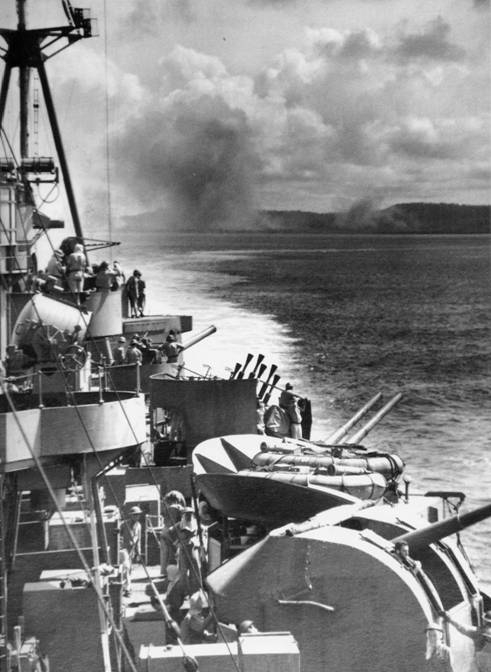- Author
- Shinkfield, Des
- Subjects
- Naval Aviation, WWII operations, History - WW2
- Tags
-
- RAN Ships
- HMAS Arunta I, HMAS Warramunga I, HMAS Shropshire, HMAS Australia II
- Publication
- December 2010 edition of the Naval Historical Review (all rights reserved)
The following speech was delivered to the Australian Naval Historical Society on Monday, 26 June, 2006
Thank you for the opportunity to speak about kamikazes. But let me enlarge on the title – ‘Kamikazes, Suicide Bombers and Us.’ The Japanese word ‘kamikaze’, as you probably know, means ‘divine wind’ and originated in 1281 when the Mogul chief, Kublai Khan, tried to invade the island of Japan with a fleet of 3000 vessels crammed with mercenaries from China and Korea. In sight of their goal a ‘divine wind’ eliminated this great fleet. Japan was saved. These winds, known to us as cyclonic winds, were called kamikazes or ‘divine winds’.
When the Japanese carrier strike force attacked Pearl Harbour on December 7th 1941, without warning and with devastating effect, such winds were not needed. All they needed were carrier borne aircraft which they used to good effect. Was the attack expected? I have reason to believe that it was, but the warnings did not get through to the White House, or if they did, no one paid any attention to them.
When I left school in 1940 I went to work in the National Bank at Northcote, WA. After a year in the branch I was transferred to the Chief Manager’s Department in Collins Street as a junior. Now and again I would see a three ring commander, resplendent in naval uniform. He was the brother of Lionel Nave, the chief manager’s secretary. I wondered what his job was. Years later I learned that it was he who had broken the Japanese code. Thanks to him the cryptographic teams were set up which enabled the Allied Forces to anticipate the Japanese advance in the Pacific.
February 15th 1941 witnessed the fall of Singapore. Bali and Timor were attacked on the 19th and 20th. A Japanese carrier force raided as far south as Darwin inflicting heavy damage. Eight or more ships were sunk, 450 people were killed. Broome was also attacked. The Philippines were overrun. General MacArthur was forced to quit, but said, ‘I will return’ and this he did, as we know, in October 1944. February 27th, ABDA, that is, the American, British, Dutch, and Australian naval forces, were annihilated in the Battle of the Java Sea. HMAS Perth was sunk. In the space of less than three months the Allies had lost two capital ships, five cruisers, a seaplane carrier and seventeen destroyers in defence of South East Asia. There was nothing to prevent the Imperial Japanese Navy from overrunning the entire western half of the Pacific.
On April 20th, a Japanese invasion force left its new fleet base at Truk, in the Caroline Islands. This move brought on the Battle of the Coral Sea, May 7th – 9th, the first battle in which the protagonists didn’t see each other, a game in which the weather proved to be a key player. It was to be a game of hide and seek with both using carrier borne aircraft. The Japanese lost a light carrier, Shoho, the carrier Shokaku was badly damaged, and Zuikaku was left with a much reduced number of aircraft. The US lost the carrier USS Lexington, the oiler USS Neosho, and the destroyer USS Sims. The US lost 75

image courtesy of Topmill Pty Ltd
aircraft, the Japanese 74. The situation on the 7th was confused due to heavy cloud. Many planes were lost and some Japanese planes attempted to land on the American carriers, mistaking them for their own. They were politely waved off! Tactically it could be argued that the Battle of the Coral Sea was a drawn battle, but strategically it went to the US Navy because it prevented the Japanese from capturing Port Moresby. Rear Admiral Fletcher had detached our Australian squadron north to the Jomard Passage without air cover to stop the Japanese invasion force from moving south and then to Port Moresby.
The Australian squadron consisted of HMA Ships Australia and Hobart, USS Chicago and three destroyers. Task Force 44 under Rear Admiral Crace was attacked by enemy aircraft, but no ship was damaged. A photo taken by Hobart suggests Australia was obliterated by waterspouts from the bombs. Thanks to bad intelligence the Japanese, thinking our forces were bigger than they were, retreated, fortunately for us.




